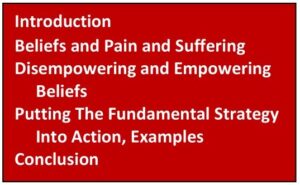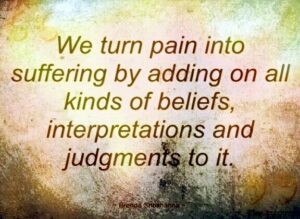Pain and Suffering Part III, Beliefs, Causes, and Responsestm
Introduction
In a previous Letter we defined pain as a specific, localized, sensation in our body. It is a negative, unwanted feeling. It is a signal from our body that something is wrong, that there is something we need to pay attention to. Suffering is a complex generalized experience characterized by some or all of—discomfort, angst, anguish, agony, and torment. Grief, sorrow, sadness, helplessness, and unhappiness can also be aspects of a person’s suffering, and pain is always present in suffering because the feelings of suffering are full of pain. In previous Letters we offered effective strategies for living as ways to avoid and minimize pain and suffering. We began our exploration of the relationship between beliefs and pain and suffering. We described a fundamental strategy for dealing with the causes and responses to pain and suffering. We gave examples of applying this strategy.
In this letter we list some beliefs that cause and increase our pain and suffering and offer additional examples of applying the fundamental strategy. You can consult the April 2024 Letter for the full discussion of the role of beliefs but you can see from the examples here how beliefs affect our pain and suffering.
BELIEFS AND PAIN AND SUFFERING

In previous Letters we described three categories of belief—core, intermediate, and operating. Core beliefs are foundational and
fundamental beliefs about ourselves and the world. Intermediate beliefs are logical extensions of core beliefs that we apply to ourself in a particular situation. And operating beliefs are beliefs that we use in our everyday life that motivate our actions. Beliefs give rise to thoughts and feelings, that give rise to emotions (the combination of thought and feelings). Emotions trigger actions.
Our beliefs can cause us physical, emotional, mental, or spiritual pain no matter what the source of the pain is or if it is avoidable or unavoidable. Our beliefs can bring on (initiate) pain or intensify the experience of pain that we are having by coloring our response. Let’s look at some core beliefs and the actions they give rise to that cause us pain and suffering.
Disempowering Beliefs
- No pain no gain. We seek pain thinking that there is some benefit to it. We ignore pain thinking that it is good for us.

- Pain and suffering come to us without our doing anything to cause them. We feel a helplessness that gives rise to passivity—not taking actions that could help us. This belief causes varying degrees of depression triggered by helplessness.
- Life is full of pain and suffering that is inevitable. While partially true, this belief causes us to resign ourselves to pain and suffering missing opportunities to take action to avoid or to resolve them.
- Pain and suffering are noble. Since we want to be noble we think pain and suffering are good for us and therefore unnecessarily seek and welcome them.
- Martyrhood is a noble approach to life. Pain and suffering enhance my life. We should follow the example set by the famous martyrs that have lived throughout history. Since pain and suffering are integral to martyrhood we actively seek and passively allow them. We resign ourselves to a lifetime of suffering.
- Pain and suffering are more powerful than we are. We then feel helpless and powerless in the face of pain and suffering. We feel fearful when faced with pain and suffering and become paralyzed. Then we cannot identify what we can do to prevent and resolve them.
- Self-sacrifice is good for our growth and is our way of giving to other people. While this is occasionally true, our self-sacrifice is self-imposed pain and suffering. We seek and create opportunities for self-sacrifice thinking that we are doing the right thing.
- God controls my life so if I am suffering it is God’s will. Therefore, I don’t trust God and cannot feel loved by God.
Point of Empowerment: Beliefs cause self-inflicted pain and suffering.
Empowering Beliefs
- Some of our pain is self-inflicted. We can eliminate this type of pain from our life.

- Our response to pain and suffering makes an immense difference in how we experience pain and suffering.
- Our response to pain is always within our control.
- Based on our experience and learning we can anticipate when our actions will create pain and suffering for us. We can act differently.
- It is wise to accept the idea that the present moment is a fact that cannot be different than it is. Healthy acceptance is not helpless and passive resignation but awareness and relaxation. Relaxing into pain and suffering, not fighting them, helps reduce the intensity of our pain and suffering.
- Guilt is the punishment inflicted upon us by our limited conscience. Though there is a place for guilt, we can develop a more constructive conscience that uses remorse, self-esteem, dignity, and love.
- Much of our pain comes from our destructive and dysfunctional approaches to life. We can correct these approaches by using effective strategies for living.
Point of Empowerment: Effective strategy for living regarding pain and suffering : identify and change your beliefs about pain and suffering from disempowering to empowering.
PUTTING THE FUNDAMENTAL THE STRATEGY FOR DEALING WITH PAIN AND SUFFERING INTO ACTION, EXAMPLES
To briefly review ideas from the April Letter, we offer the Processing Pain and Suffering chart that outlines the fundamental strategy for dealing with pain and suffering.
Processing Pain and Suffering
| Description of a specific pain | Type of pain: Physical, Emotional, Mental, Spiritual | Cause | Disempowering Belief | Empowering Belief | Effective strategy for living |
PUTTING THE FUNDAMENTAL STRATEGY INTO ACTION, EXAMPLES
Example
Cause: Event—My son left his coat at school despite my request that he bring it home. He does not take care of or appreciate his things. I feel extremely frustrated and angry. These feelings wake me up at night. I can’t sleep.
The pain: emotional—frustration and anger; external and unavoidable—caused by an event; internal and avoidable—caused by my emotional reaction to the event.
Core belief: Children should value and appreciate what their parents buy for them. Children should cooperate with reasonable parental requests.
Dysfunctional Core belief: Children should always value and appreciate what their parents buy for them and obey their parents’ wishes. Also, if my son does not value his things he does not value me since I bought them. These beliefs intensify the emotional responses causing more frustration and anger than appropriate or necessary. This intensification is self-inflicted pain.
Intermediate belief: Parents should talk to their children about the importance of valuing and appreciation and follow up with instructive consequences if necessary. Parents should teach about valuing and appreciation by setting a good example, by being a good role model. Parents should work with their children to obtain cooperation with reasonable requests rather than demanding blind obedience.
Dysfunctional Intermediate belief: Children should be taught appreciation by lecture, admonishment, or punishment if they do not show appreciation. Compliance with requests should be demanded with punishment for lack of cooperation. My son is unappreciative of my efforts therefore he does not value me. My frustration and anger are further intensified by dysfunctional intermediate beliefs. This is self-inflicted pain.
Operating belief leading to action: I should do something to teach valuing and seek cooperation.
Dysfunctional operating belief leading to action: I will scold, lecture, and punish my son until I get the right attitudes and obedience from him.
Evaluation of strategy: This is an overreaction that will cause excessive pain for the son and for the parent as the son will resist, rebel, (silently if not openly), and will not learn anything that the parent desires to teach. The natural feeling of frustration is followed by intensified and unnecessary anger and the desire to punish.
Effective strategy for living: Identify the excessive pain that is present. See if the chosen parenting techniques get the desired results. Research useful parenting techniques or talk with other parents about what works for them. Put the new strategies that you have learned into action and observe the consequences. Examine and change the beliefs that are not getting you what you want.
Example
Cause: Event—I have been reflecting on the pain and suffering in my life.
Core belief: Life brings us pain and suffering but with strength and resilience I can respond in ways that minimize this pain and suffering.
Intermediate belief: I am strong and resilient.
Operating belief leading to action: My friend rejected me but being strong and resilient I experience the pain of this rejection, reflected on the relationship with my friend, release the pain, and move on.
Effective strategy for living: I feel my pain. I utilize my inner resources of strength and resilience, release the pain, determine and resolve the causes of the pain, put what I have learned into practice, and move on. Also, whenever something happens that does not seem right I ask myself, “What must I believe that creates or influences this?”
Practice: Discover your beliefs about pain and suffering in general and about the pain and suffering you are experiencing in a present moment. State, “These are my beliefs about pain and suffering. I believe . . .” and fill in the blank writing down everything that you think.
Or state, “I am experiencing pain at this moment. My beliefs about this pain are . . .” and fill in the blank writing down what you think. Work with beliefs that seem to prevent you from coping with this pain and the beliefs that increase the intensity of a painful feeling that you are experiencing.
Practice: Develop personality traits, like strength, resilience, and courage, that will enable you to respond more effectively to the pain and suffering in your life.
Practice: Continually revise the strategies that are not getting you what you want and develop new effective strategies for living.
CONCLUSION
In this Letter we reviewed concepts from past Letters regarding the nature, functioning, and resolution of pain and suffering. We described how our beliefs cause pain and suffering. We explained how our beliefs make our pain and suffering more intense than necessary making coping more difficult than it has to be.
We referred to martyrhood as a distinct pattern of thoughts, feelings, and behaviors that is seen as desirable by almost every culture around the world. Therefore everyone has some impulse toward martyrhood, some people more than others. In reality martyrhood is a source of unnecessary self-inflicted pain and suffering.
Point of Empowerment: The most difficult and therefore the most useful approach to pain and suffering is to ask, “How have I created this experience for myself?” And the only way to be able to approach your pain and suffering with this question is to have rock solid self-acceptance.
Point of Empowerment: This is profound work that can lead to alleviating some of our pain and suffering. If we extend ourselves more deeply, using what we have learned, we can transform our self and our life.
(We extensively explored beliefs and changing beliefs in other Letters. To reach these Letters click on the link to the Letters Index and scroll down to find the section called The Foundation of Your Life: Beliefs. https://iifsd.org/library/newsletters/)
